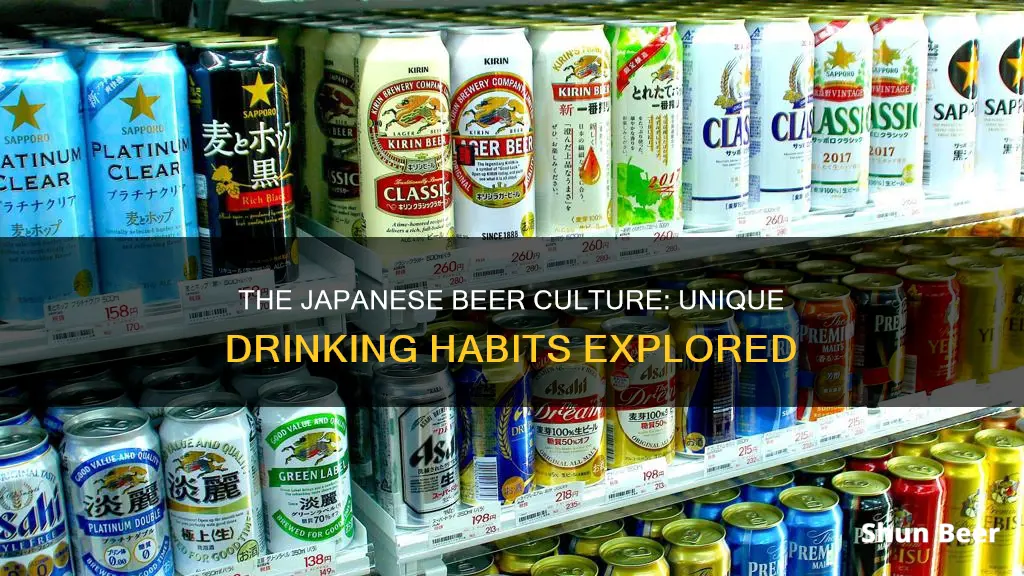
Japan has a unique drinking culture, with alcohol playing a significant role in both social and business contexts. Beer is the most popular alcoholic beverage in the country, with major brands including Kirin, Asahi, Sapporo, and Suntory. Drinking is deeply ingrained in Japanese society, and it serves as a way to foster camaraderie and strengthen relationships. This is reflected in the concept of nomikai, which refers to after-work drinking sessions that facilitate open communication and bonding between colleagues. The act of drinking together is believed to allow individuals to express their true feelings and strengthen social and professional connections.
| Characteristics | Values |
|---|---|
| Most popular alcoholic drink | Beer |
| Beer brands | Kirin, Sapporo, Suntory, Asahi |
| ABV | 5% |
| Beer-like beverages | Happoshu, New-genre beer |
| Beer consumption locations | Homes, drinking establishments, restaurants, bars, izakaya |
| Beer consumption occasions | After-work drinking sessions, social gatherings |
| Beer availability | Draft, bottled, cans, vending machines |
| Beer drinking etiquette | Never pour a drink for yourself, always say "kampai" ("cheers") |
What You'll Learn

Japanese drinking etiquette
Drinking is an important part of Japanese culture, both socially and professionally. It is seen as a way to build trust and strengthen relationships, and many business connections are forged over drinks. However, there are several rules of etiquette to follow when drinking in Japan.
Firstly, it is considered rude to pour your own drink. Instead, wait for a friend or host to pour for you, and make sure to reciprocate by keeping their glass topped up. When pouring for someone else, use both hands to hold the bottle, and ensure the label is facing up. The person receiving the drink should hold their glass at a slight angle to facilitate the refill.
Secondly, it is customary to wait until everyone has received their drink before starting to drink. This is also true of meals in Japan. Once everyone is served, a toast is usually made. The most common toast is "kanpai", which means "cheers", but you may also hear "omedetou" ("congratulations") or "banzai" ("to live 10,000 years"). When clinking glasses, your glass should be at a lower angle than that of your superior or elder.
Thirdly, drinking sessions in Japan can go on for hours, so it's important to pace yourself. It is acceptable to refuse drinks or to drink slowly. Drinking is usually accompanied by food, which helps to slow down alcohol consumption and prevent excessive intoxication. Light snacks, or "otsumami", are the Japanese equivalent of Western bar snacks, and may include edamame, shredded squid, or rice crackers.
Finally, it is considered rude to leave a drinking session early. You should wait for the host or a superior to decide when the party is over. If you know you need to leave early, it's best to let the host know in advance and make arrangements for payment.
Beer and Exercise: Is It Safe to Work Out Post-Drink?
You may want to see also

Beer brands in Japan
Beer is the most popular alcoholic drink in Japan, and the country has four major breweries: Asahi, Kirin, Sapporo, and Suntory. These breweries produce pale lagers with an ABV of around 5%. However, there are also several microbreweries and craft beer options available.
Asahi
Asahi is one of the oldest beer brands in Japan, dating back to 1889 when it was founded in Osaka as the Osaka Beer Company. Its world-famous Super Dry is credited with transforming Japan's modern beer industry by introducing a light profile similar to certain German lagers. Asahi Super Dry has a crisp and dry taste, making it perfect for food pairings as it won't overpower the unique flavours of the cuisine. It has an ABV of 5%.
Kirin
Kirin is another one of Japan's most beloved beer brands. It began as the Spring Valley Brewery, a private business established by Norwegian-American William Copeland in Yokohama in 1869. One of their perennial best-sellers is Kirin Ichiban, an all-malt lager with a dry taste and mild bitterness, with an ABV of 5%.
Sapporo
Sapporo is Japan's oldest beer brand, founded in 1876 as part of a government-backed development plan for Hokkaido. Sapporo Premium is a traditional lager with hints of sweetness and a very clean taste. It has an ABV of 4.9%.
Suntory
Suntory is another major beer brand in Japan, known globally for their whisky. Their award-winning Premium Malt's is crafted in the pilsner style using carefully selected malt, hops, and 100% natural water. It has a higher ABV of 5.5% compared to other major brands, but it is still easy to drink and is hugely popular throughout Japan.
Microbreweries and Craft Beer
Since deregulation in 1994, microbreweries have become increasingly popular in Japan, supplying distinct-tasting beers in a variety of styles. Craft beer bars and pubs are also prevalent in major cities like Tokyo and Osaka, with a focus on locally produced and imported beers from the US and Europe. Notable microbreweries include Yoho Brewing, which produces the popular Tokyo Black Porter, and Kiuchi brewery, which was the first Japanese microbrewery to export beer internationally.
Beer and Sickness: What You Need to Know
You may want to see also

The history of beer in Japan
The Edo Period (1603-1868)
The origins of beer in Japan date back to the Edo period, when the country was under the rule of the Tokugawa Shogunate. During this time, Japan adopted a strict policy of national isolationism, known as "Sakoku," which limited foreign influence and trade to only a few countries like the Netherlands and China. In 1613, a British trading ship introduced beer to Japan, arriving in Hirado, Nagasaki prefecture. However, due to its scarcity, beer was considered a luxury good during this period.
The Meiji-Taisho Period (1868-1926)
The Meiji-Taisho Period saw significant developments in Japan's beer industry. In 1869, the Yokohama Brewery was established as the country's first beer brewery, founded by a man named Rosenfeld with a Jewish background. Beer production during this time was mostly conducted by foreigners, as it was not widely accepted by the Japanese. In 1870, the Spring Valley Brewery was founded by American brewer William Copeland, and in 1872, Shibutani Beer, Japan's first native brewery, was opened in Osaka by Shibutani Shozaburo. The late 19th century also marked the beginnings of world-famous Japanese beer companies, including Sapporo, Kirin, and Asahi.
The Showa-Reiwa Period (1926-Present)
The Showa-Reiwa Period witnessed the impact of economic depression and World War II on beer consumption and production. During the war, alcohol service and beer prices were strictly controlled by the government, and there was a decrease in the production of essential ingredients like barley and hops. After World War II, Japan's beer sales recovered due to the government's policy change, allowing shops and restaurants to serve beer freely. The high economic growth from the mid-1950s to the early 1970s, coupled with technological advancements like the refrigerator, contributed to the increasing popularity of beer as a casual drink at home.
Today, Japan's beer market offers a diverse range of options, including craft beer, local brands, and alcohol-free alternatives. While beer remains immensely popular, there is a noted decline in consumption among younger generations, who are less inclined towards the bitter taste of traditional beer. Instead, newer types of beer with healthier ingredients and sweeter flavours are gaining traction.
Drinking Two Beers Daily: Is It Harmful?
You may want to see also

The craft beer scene in Japan
Japan's craft beer scene has been steadily growing since the mid-1990s, when the government relaxed the minimum production requirements for obtaining a brewing license. This change sparked the birth of the country's craft beer market, allowing smaller breweries to enter the industry and offering beer enthusiasts a diverse range of new styles, including IPAs, ales, stouts, and Belgian beers.
Prior to this, beer in Japan was dominated by the "Big Four" brands: Asahi, Kirin, Sapporo, and Suntory. These mass-produced lagers and pilsners have long been synonymous with the image of beer in the country. However, with the emergence of craft breweries, consumers now have the opportunity to explore a wider range of beer styles and flavours.
The craft beer movement in Japan is characterised by a focus on producing beers that are not lagers, aiming to offer something different from the established brands. As a result, craft breweries tend to emphasise pale ales, India pale ales, wheat beers, stouts, and porters, as well as fruit beers that showcase local produce.
While the craft beer scene in Japan is still centred around major cities, it has gained significant traction. Nearly every decent-sized city boasts at least one bar specialising in craft beer, and beer festivals dedicated to craft beer are increasingly common. This growth is particularly remarkable given that the Japanese craft beer industry is only about 25 years old.
Despite the challenges posed by the lack of a homebrewing culture and high beer taxes, craft brewers in Japan are forging ahead. They are creating innovative and traditional-style beers, enriching the country's drinking culture, and providing consumers with an alternative to the mass-produced lagers that once dominated the market.
Antibiotics and Alcohol: One Beer, Any Harm?
You may want to see also

Where to buy beer in Japan
Beer is the most popular alcoholic drink in Japan, and there are several options for purchasing it. The country's drinking culture is a blend of tradition and modernity, with alcohol playing a significant role in social and business interactions. Here's a guide on where to buy beer in Japan:
Supermarkets and Convenience Stores
Beer can be found in supermarkets, department stores, and convenience stores (known as "konbini" in Japanese). Popular konbini chains include Lawsons, 7/11, Circle K, and Family Mart. These stores offer a range of alcoholic beverages, including beer, and are easily accessible throughout Japan.
Liquor Stores (Saka-ya)
Specialty liquor stores, known as "saka-ya", provide a wide selection of alcoholic drinks, including beer. These stores often have knowledgeable staff who can guide you in selecting the right beer for your taste and occasion.
Vending Machines
Japan has the highest number of vending machines per capita in the world, and these machines offer a convenient way to purchase beer and other drinks. Vending machines are located on street corners, train stations, and other public places, making it easy to grab a beer on the go.
Izakaya
Izakaya are traditional Japanese drinking establishments that also serve food. They offer a wide range of alcoholic beverages, including beer, and are a great place to experience Japan's unique drinking culture. Izakaya often have nomihodai deals, which allow you to drink as much as you like for a fixed price within a certain time limit.
Online Shopping
If you're looking for a specific craft beer or import, online shopping is a convenient option. Websites like Hopbuds, Rakuten Ichiba Beer Site, and Yahoo! Japan Shopping Beer Site offer a wide range of beers that can be ordered from the comfort of your home. These sites often accept credit card payments and offer delivery services.
Restaurants and Bars
Restaurants and bars in Japan typically serve beer, and it is customary to drink with a meal or a light snack called "otsumami." When dining out, you can expect to find a variety of beer options, including local and imported brands.
Karaoke Box
Karaoke culture is prevalent in Japan, and karaoke boxes often offer drinking deals alongside singing packages. While the drink selection may be more limited, it's a unique way to enjoy beer and experience Japanese entertainment culture.
Beer and Ulcers: Is It Safe to Drink?
You may want to see also
Frequently asked questions
Drinking plays an important role in Japanese society and is deeply ingrained in social and business interactions. The country's drinking culture is a blend of tradition and modernity, with ancient rituals of sake consumption coexisting alongside modern phenomena like after-work "nomikai" (drinking parties). Alcohol serves as a social lubricant, helping to build trust and strengthen relationships.
Beer is the most popular alcoholic drink in Japan, with major brands including Kirin, Asahi, Sapporo, and Suntory. Sake, also known as nihonshu, is Japan's unofficial national spirit and is made from rice. Other popular drinks include shochu, whisky, umeshu, and chuhai.
Yes, there are a few things to keep in mind when drinking in Japan. Firstly, it is considered rude to pour a drink for yourself. Instead, your friends, colleagues, or host should pour your drinks, and you should also ensure their glasses are full. Secondly, it is polite to wait until everyone has their drink before starting to drink. Lastly, drinking is usually accompanied by a meal or "otsumami" (light snacks) such as edamame, shredded squid, or rice crackers.







